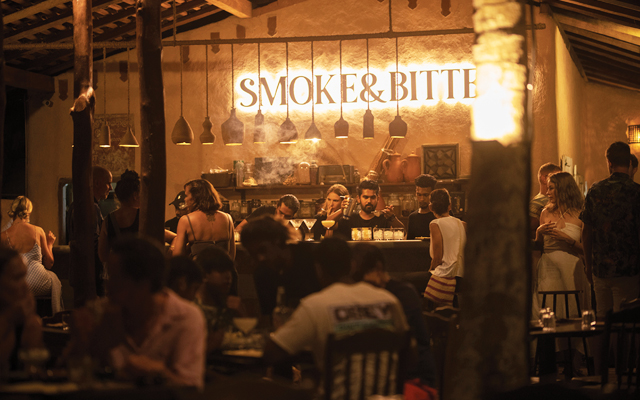Defying public misconceptions about a starving, troubled country, Sri Lanka’s tourism and hospitality players are ready to welcome the world with flavourful feasts and a warm embrace.
Ambul thiyal, polos, wambatu moju, kola kanda and kiribath – some of Sri Lanka’s beloved dishes are often unfamiliar to those setting foot on the South Asian island country for the first time, and hint at the swathes of gourmet discoveries waiting to be unravelled by food lovers.
Over dinner with TTG Asia, Manoj Devaraj, group head – sales and marketing, Teardrop Hotels, and Chamintha Jayasinghe, co-founder of luxury travel curator Ayu in the Wild, said Sri Lankan cuisine is often misunderstood to be the same as that of neighbouring India.

“Both make different use of spices and cooking styles. We consume a lot more seafood here. Our food has huge influences from our historical interactions with the Portugese, Dutch, Arabic and English,” defined Devaraj.
Furthermore, different cooking styles across the country – from north to south and from coastline to hill country – also birth unique flavours and dishes, pointed out Jayasinghe.
Travellers looking to take their first bite can start onboard SriLankan Airlines, where inflight meals have recently been reinvented to showcase traditional food and its nutritional benefits. Themed Sri Lankan Flavors, the airline’s local meal options are available onboard long- and medium-haul flights as well as at its Business Class lounges at Bandaranaike International Airport in Colombo. Some home favourites on the menu include polos baby jackfruit curry and kuruluthuda rice with chicken pepper curry, as well as a wide selection of local tea.
Richard Nuttall, CEO of the flag carrier, said: “The idea is for passengers to experience Sri Lanka right from the moment they are onboard. Our food philosophy has always been to reflect the country’s culinary culture. We often hear from our Sri Lankan customers that the best local breakfast is found on SriLankan Airlines.”
Another memorable way to get acquainted with Sri Lankan cuisine is through lunch prepared by village folks, served and eaten on a kamatha – a clearing in the middle of lush paddy fields. Arranged by Ayu in the Wild, the kamatha lunch experience introduces guests to the life of rural farmers back in the good old days as well as their traditions. As the space is sacred, only vegetables and non-alcoholic beverages are allowed there along with positive chatter. Farming families involved in delivering the experience gain additional income – a point of appeal for travellers who want to ensure that their spend reaches the hands of the local community.

Food lovers can even recreate their favourite Sri Lankan dishes back home, following an immersive cooking class led by a chef of Shangri-La’s Hambantota Golf Resort & Spa. The Spice Tales activity sees guests joining the chef at the fishing harbour and vegetable market to score some fresh ingredients before returning to the kitchen to prepare their own tasty lunch. Guests are also gifted a pack of essential Sri Lankan spices and a recipe book.
For a more modern take on Sri Lankan flavours, head to Paradise Road The Gallery Café, set in a stylish section of Colombo. Here, a mix of western and Sri Lankan dishes – such as curried fish head soup and coconut crusted modha fish – are served beautifully plated and accompanied by creative cocktails.
Yet another pleasant surprise awaiting visitors is Sri Lanka’s vibrant and cosmopolitan food scene – a vastly different view compared to recent portrayals of civil unrest and resource shortages in some mainstream media. While those were issues the country had to grapple with in 2022, the authorities and people have since established systems to ensure critical resources – including food and fuel – are available to most residents as well as tourists.
“Some imported items, like wine and cheese, may not be easily available here now, but that is only due to an import curb to preserve foreign currency reserves. This does not affect Sri Lanka’s ability to feed tourists, who can continue to enjoy dishes and beverages made with fresh local produce,” Jayasinghe told TTG Asia in early January.

Echoing her view, Nuttall emphasised: “We need tourists to understand that they are not taking food away from Sri Lankans. It is the high cost of living that has resulted in some families not having enough money to buy as much protein as they need. In fact, the return of tourism and tourist expenditure can allow more Sri Lankans to generate more income to feed their families.”
At press time, tourism is stirring once more in Sri Lanka. Visitors who came calling in December 2022 and January this year found popular dining and entertainment venues buzzing at meal times, after dark and over weekends.
Both Sri Lankan flavours and international alternatives are widely available in the tourist hubs, from Colombo and Galle to Hiriketiya and Hambantota.
At Park Street Mews in the capital city, where old warehouses have been converted into an entertainment district, guests can enjoy Japanese, South-east Asian, Middle Eastern, Italian, French favourites and more from across eight restaurants.
Over at the UNESCO World Heritage Site Galle Fort, travellers benefit from a lively dining scene populated by stylish restaurants, cafés and bars tucked within conserved buildings and reimagined boutique hotels. For food lovers, Galle Fort is a gourmet paradise to be slowly savoured across several days.
And should sensible living be needed after days of indulgence, check into luxury coastal resort, Amanwella, where executive chef Shantha Peiris will nourish guests with balanced meals. Peiris takes pride in using traditional herbs and spices harvested from the onsite gardens and forest to create dishes served across the resort’s F&B venues. Menus change with the season, and can be customised according to the dietary needs of guests.
Travellers who scrutinise their carbon footprint and value opportunities to support the local community will be heartened to know that several hospitality operators in the country have intensified sourcing from producers at home. Such decisions were borne out of practical need – supply chain disruptions during the pandemic and earlier import curbs on certain ingredients – as well as a conscious desire to uplift local communities as these operators rebuild their business.
Teardrop Hotels, which run seven hotels across the country, has improved the conditions of its four fruit and vegetable gardens since 2020 for better harvests. Today, 30 per cent of its fruit and vegetable supplies are from these gardens.
Seafood, meats and other ingredients are also obtained from local producers “as much as possible”, shared Devaraj.
Close to 85 per cent of ingredients used in Teardrop Hotels kitchens are now locally sourced – up from about 60 per cent pre-pandemic.
“We have even looked at how suppliers work with us,” he added. To encourage local producers to deliver orders more sustainably, the company supplied reusable, stackable crates.
“The pandemic and import disruptions made us realise that relying on local producers is more reliable, offers greater value, and enables us to support our own people,” Devaraj said.
Smoke & Bitters, a cocktail bar and smokehouse that sits on Hiriketiya’s Pehebiya Beach, takes pride in supporting local producers. A product of two Sri Lankan sons with vast global F&B experience, Smoke & Bitters sources almost 100 per cent from local producers, resulting in an award-winning cocktail menu built on local rum, arrack and home-made syrups, as well as a tantalising food menu featuring dishes prepared with traditional smoking techniques.

Shangri-La’s Hambantota Golf Resort & Spa, too, is keen to source more of its food supplies from within the country. It plans to engage a village near Yala to supply the hotel with vegetables.
“This community is dependent on seasonal wildlife safari. By having them grow and supply food to our hotel, they can earn income during the off-season,” explained general manager Refhan Razeen.
As the best holiday memories are made of glorious food and exquisite experiences, Jayasinghe believes that “Sri Lanka is absolutely ready to welcome travellers”.
Jayasinghe, who connected TTG Asia with various hotels and dining venues on a research trip in January, said: “Anyone who visits today will realise that this is a country with everything.”
Sri Lanka is gifted as a tourist destination, she opined, thanks to its varied geography and attractions, ranging from whale watching and nature parks to community-based tourism opportunities and specialised tours for those keen to learn about the country’s archeology, conservation efforts, culture, heritage and more.
















